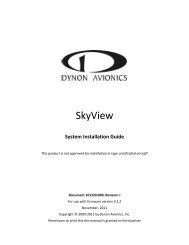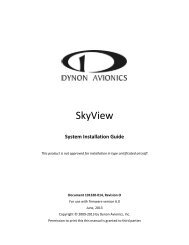EFIS-D100 Electronic Flight Information System - Dynon Avionics
EFIS-D100 Electronic Flight Information System - Dynon Avionics
EFIS-D100 Electronic Flight Information System - Dynon Avionics
Create successful ePaper yourself
Turn your PDF publications into a flip-book with our unique Google optimized e-Paper software.
Available Pages<br />
The CDI is located just above the slip/skid ball when displayed, and behaves much as described in the HSI Operation<br />
section on page 6-1. The CDI needle is green when sourced from a NAV radio and magenta when sourced from GPS.<br />
When to/from information is available, the center of the CDI is an arrow; when on an ILS, it is a filled-in square.<br />
The glideslope indicator is located to the left of the roll scale tape, and behaves much as described in the HSI Operation<br />
section on page 6-1. The GS needle is green when sourced from a NAV radio and magenta when sourced from GPS, and<br />
appears only when tuned to an ILS or a GPS source with vertical guidance.<br />
Due to screen space limitations, turning on the glideslope prevents a left info item from being displayed on the 2/3-<br />
screen <strong>EFIS</strong> page. Additionally, at extreme roll angles, the glideslope is hidden to provide space for other screen<br />
elements.<br />
Stabilized heading tape and digital readout<br />
Located at the top of the <strong>EFIS</strong> page, the heading indicator<br />
functions much like a standard slaved directional gyro. North,<br />
East, South, and West directions are labeled on the tape, “N,” “E,” “S,” and “W,” respectively. The digital readout<br />
displays your current heading, while the surrounding tape scrolls beneath its arrow. You may set a yellow bug on this<br />
tape as a heading reminder. The pointer in the digital readout is hollow to allow the GPS ground track indicator,<br />
displayed as a magenta arrow, to show through. A difference between the ground track arrow and the current heading<br />
indicates that some wind is present. The currently set course heading is represented by a “V,” colored green when<br />
sourced from a NAV radio and magenta when sourced from GPS. When the CDI is centered, aligning the ground track<br />
pointer within the course pointer compensates for all wind and takes you directly to the waypoint or VOR. For course<br />
and ground track to be displayed on the heading tape, they must both be enabled in the CLUTTR menu.<br />
Like a conventional gyro-stabilized magnetic compass, magnetic heading reacts immediately to turn rate so that heading<br />
changes are reflected immediately. It then uses magnetometer data over the long term to ensure that it remains correct.<br />
Additionally, heading is corrected for attitude so that it is accurate as you pitch and roll.<br />
4-4 <strong>EFIS</strong>-<strong>D100</strong> Pilot’s User Guide
















